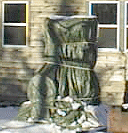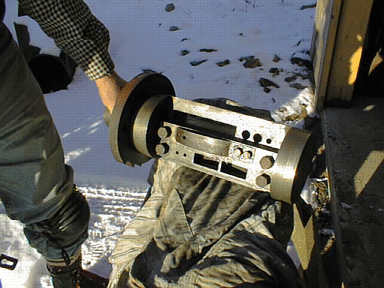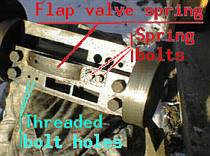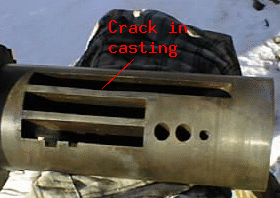

 The Alldays and Onions 300-pound air hammer sits outside on its
concrete pad wrapped in tarps — in "Christo Tribute" mode as my
wife cleverly observed — waiting for better weather.
The Alldays and Onions 300-pound air hammer sits outside on its
concrete pad wrapped in tarps — in "Christo Tribute" mode as my
wife cleverly observed — waiting for better weather.
 This side of the valve shows the flap valve which consists of a thin
piece of springy steel held in place with two bolts and a much
heavier, bowed spring. The thin steel sheet works as a one-way valve,
lifting off of the ports it covers when pressure is greater on one
side but slapping tightly shut when pressure is greater on the other side.
This side of the valve shows the flap valve which consists of a thin
piece of springy steel held in place with two bolts and a much
heavier, bowed spring. The thin steel sheet works as a one-way valve,
lifting off of the ports it covers when pressure is greater on one
side but slapping tightly shut when pressure is greater on the other side.
 It appears that there is supposed to be two such flap valves and that
one is missing. There are two open ports, similar to those covered
by the existing flapper, threaded holes for the retaining bolts and
some wear marks indicating that there was once a second valve in
place. Figuring this out will have to wait for spring when I can
examine the airways in the hammer carefully.
It appears that there is supposed to be two such flap valves and that
one is missing. There are two open ports, similar to those covered
by the existing flapper, threaded holes for the retaining bolts and
some wear marks indicating that there was once a second valve in
place. Figuring this out will have to wait for spring when I can
examine the airways in the hammer carefully.
 This is the other side of the valve — 180 degrees around from
the previous image — and shows the other side of the valve
ports. The valve body weighs around 90 pounds and fits very nicely
into a sleeve insert in the hammer body. Just a little surface rust
made it difficult to remove. Its own weight is enough to cause it to
bind in the sleeve when half way out unless it's supported carefully.
This is the other side of the valve — 180 degrees around from
the previous image — and shows the other side of the valve
ports. The valve body weighs around 90 pounds and fits very nicely
into a sleeve insert in the hammer body. Just a little surface rust
made it difficult to remove. Its own weight is enough to cause it to
bind in the sleeve when half way out unless it's supported carefully.
 It appears that someone had difficulty removing it at one time and
attempted to solve the problem by inserting a bar into one of the
ports in the valve body for leverage. There is a crack in the casting
and a slight displacement of the web between two ports.
It appears that someone had difficulty removing it at one time and
attempted to solve the problem by inserting a bar into one of the
ports in the valve body for leverage. There is a crack in the casting
and a slight displacement of the web between two ports.
 And here's what I hope to drive the hammer with: a single cylinder gas
engine made by the now defunct
Acadia Gas Engine Co.
in Bridgewater, Nova Scotia. It's equipped with a magneto ignition
and I've had it running. The valve train — not too clear in
this photo — isn't complete and some other small parts need
repair but happily I got the manual and parts list from the Acadia
plant manager a year or so before they closed up for good. Engines
like this were installed all over Nova Scotia on federal contract at
government wharves to be used by fishermen to haul their boats out on
skidways. Those engines were equipped with sprockets and a cable
winch. Mine has a flat belt pulley.
And here's what I hope to drive the hammer with: a single cylinder gas
engine made by the now defunct
Acadia Gas Engine Co.
in Bridgewater, Nova Scotia. It's equipped with a magneto ignition
and I've had it running. The valve train — not too clear in
this photo — isn't complete and some other small parts need
repair but happily I got the manual and parts list from the Acadia
plant manager a year or so before they closed up for good. Engines
like this were installed all over Nova Scotia on federal contract at
government wharves to be used by fishermen to haul their boats out on
skidways. Those engines were equipped with sprockets and a cable
winch. Mine has a flat belt pulley.
UPDATE: The Acadia engine needs a replacement magneto or some serious work on the existing one. And I haven't figured out how to mount a clutch pulley on it in a tidy fashion yet. Couldn't wait to find out if this thing works so we rigged up a friction-drive power source.